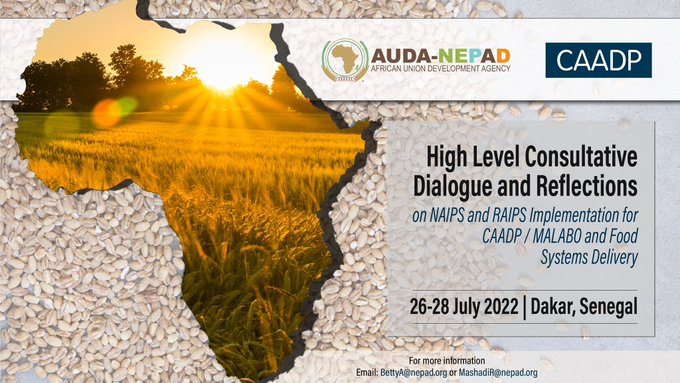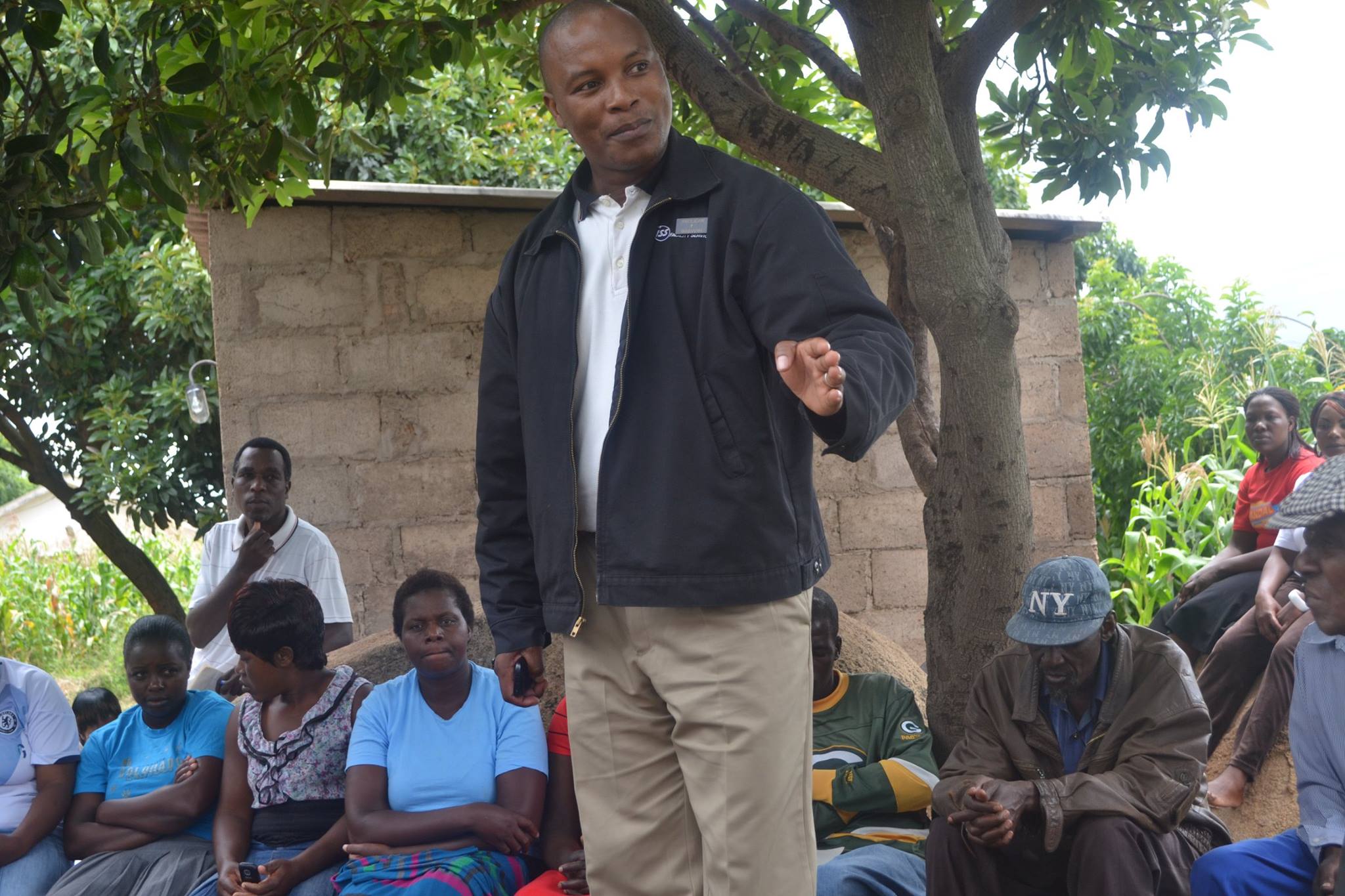|
Getting your Trinity Audio player ready...
|
The African Union Development Agency (AUDA-NEPAD) and the African Union Commission Department of Agriculture, Rural Economy and Blue Economy (AUC-DARBE) in association with Akademiya2063 will be holding a high-level stakeholder consultative meeting in Dakar, Senegal, from 26 to 28 July 2022 to review the Comprehensive Africa Agriculture Development Programme’s National Agricultural Investment Plans (CAADP/NAIP) success and provide recommendations that will inform the next NAIPs cycle post-Malabo.
In 2003, the African Union (AU) Heads of State and Government Summit in Maputo, Mozambique, adopted the Comprehensive Africa Agriculture Development Programme (CAADP), as a policy framework to stimulate and guide the attainment of food security and poverty reduction goals in Africa. To underscore the commitment to agriculture development, the 2003 AU Summit further adopted a resolution to commit at least 10% of the annual public budget to agriculture and rural development and achieve agricultural GDP growth rates of at least 6% per annum.
A decade of CAADP implementation realised a number of transformational successes. As of June 2015, 40 countries had engaged and launched the CAADP process and signed the CAADP Compacts whilst 32 countries had translated their compacts into National Agriculture and Food Security Investment Plans and were at different stages of implementation. In marking the 10-year milestone of CAADP, the NEPAD Agency in liaison with the African Union Commission (AUC) and regional economic communities (RECs) led broad-based consultations and analytical work to review the gains and especially to embrace the lessons in determining drivers for CAADP over a second decade (Ref: Sustaining the CAADP Momentum).
At the 23rd Ordinary Session of the AU Assembly in Malabo, Equatorial Guinea (26-27 June 2014), the Heads of State and Government (HS&G) adopted a Declaration on Accelerated Agricultural Growth and Transformation for Shared Prosperity and Improved Livelihoods (Doc. Assembly/AU/2(XXIII) (hereafter the “Malabo Declaration”). The Malabo Declaration, based on the CAADP Results Framework, highlights seven commitments as frontline (dashboard) indicators for progress and impact on the 10-year vision and goals of the Africa Accelerated Agricultural Growth and Transformation (3AGT) agenda. These seven commitments include a commitment to accountability to ensure necessary action, tracking of results and impact as well as learning guided by the CAADP Results Framework.
The Malabo Declaration for Agricultural Transformation in Africa and Agenda 2063 is unprecedentedly clear and concrete on Africa’s priorities and agenda on the continent’s agricultural transformation trajectory. Now, and rightly so, attention must shift to “how to make it happen”, taking into account the local political economy including socio-economic and ecosystem conditions.
Recall that Agriculture is central in all the development agreements/commitments because of the direct link and implication it has on various aspects of the socioeconomic trajectory – from food security and nutrition, building industry and manufacturing through to job creation and expansion of accessible economic opportunities for large sections of the continent’s population.
In this context, agriculture and the agricultural transformation agenda seize to be a sector issue – but highly intersectoral, pushing to the boundaries the knowledge and experiences on multi-disciplinary, multi-sectorial, and multi-partner collaborations, alliances, and partnerships – horizontally as well as vertically (recognising the critical role of regional integration).
With the CAADP Implementation Strategy and Roadmap (IS&RM) and the CAADP Programme of Work (PoW) in place and having consulted with member states (PS Retreat; and regional Seminars with Regional economics Communities – COMESA, ECCAS and ECOWAS member states), there was clear urgency to operationalize at country and regional level in form of practical guidelines on how countries and regional institutions will build on their gains and lessons from the Maputo Declaration and embrace and transition to the Malabo Declaration.
Nearing the end of the second decade (MALABO Declaration) of the NAIP and RAIP implementation, it is of paramount importance to take stock of how far NAIPs/RAIPs were instrumental in driving the agriculture transformation processes and building resilient food systems. The envisaged stocktaking exercise will attempt to address the following:
Establish the status of the NAIPs and RAIPs implementation in member states
In the process of appraising the status, identify implementation-related lessons (including implementation challenges, opportunities, drivers and levers, what blocked or enhanced implementation, etc…)
Identify the “WHAT and How” to enhance and position the NAIPs as key framework and Pillar for alignment, harmonization and coherence as well as coordinated drive in the design/planning and implementation of agriculture and food systems programmes (in pursuit of the CAADP-Malabo goals as well as national and regional commitments in the Food systems Summit)
Discuss thematic emerging issues such as disruption of food supply due to shocks, climate change effect on agriculture, digitalization,
Develop a roadmap on the next steps for the CAADP 3rd Decade cycle
The Programme of Work of CAADP specifically identified key Programme Areas on (1) developing the new Malabo CAADP Guidelines, (2) conducting NAIPs appraisal for the 2nd CAADP cycle and aligning to the Malabo targets, (3) developing harmonization of Communication and Social marketing, (4) designing the biennial CAADP review cycle, and (5) supporting programme preparation. Within those programmes areas, the NAIPs appraisal was seen as the result of the identification of specific country needs to be able to conduct their systemic transformation for achieving the Malabo Goals.
As of now, the AUC has conducted a survey in the 55 AU Member States to identify these needs, the AUDA-NEPAD conducted a preliminary study on the NAIP appraisals, with support from partners including GIZ. Based on the above-mentioned work, there was a need to harmonize this knowledge and define the scope of the NAIPs appraisal which should be consistent with the reality in the countries. That exercise was completed at the inception of the Malabo CAADP process.
In addition, there was a need to prepare a detailed work programme to support and facilitate the development, strengthening and aligning of tools and platforms and capacity at all levels for the Biennial Review Cycle. This has helped define a detailed operational architecture for implementing the Biennial Review Cycle (at national, regional and continental levels) and the linkages across the levels; review tools and platforms and how the CAADP Results Framework is used.
Recall that the purpose of the NAIPs (Hendricks et al. 2018) is to provide a plan of action to achieve the Malabo commitments through a bundle of interventions aimed at stimulating agricultural growth to reduce poverty and inequality and achieve improved food security and nutrition. NAIPs should therefore transcend sector plans, providing a multi-sectoral and multi-stakeholder initiative within the framework of the national, regional, continental and international development frameworks.
As such, one of the unique features of the Malabo commitments and the design of the second-generation NAIPs (or NAIP IIs) is a far greater alignment of targets and impacts with national transversal development frameworks (as NDPs which include the Constitution, National Development Plans, Medium term Strategic Frameworks and Sector Plans), global commitments (such as human rights right to be free from hunger, children’s rights and multiple others), as well as the SDGs.
In addition to the aforementioned scope, comes the acknowledgement of various continental and global trends, Africa’s youthful population, the advent of digital tools and infrastructures, the outcomes of the United Nations Food Systems Summit (UNFSS), the various shocks and stresses that the agriculture sector has been exposed to recently (fall army worm outbreaks, drought, flooding, locust infestation, COVID, now the Ukraine-Russia crisis, etc.).
The Dakar High-Level Meeting, with a focus on IMPLEMENTATION and delivering RESULTS, brings together various players and stakeholders for a comprehensive and integrated:
a)Examination of factors and trends enhancing (or constraining) implementation and delivery of transformative results/impacts in Africa’s agriculture and food systems (refer to CAADP-Malabo decision and UN FS Summit national commitments and Africa Common Position on Food Systems)
b) Alongside the latest appraisal of NAIPs – RAIPs implementation status, Examine NAIPs (and RAIPs at the regional level) as a core implementation tool for CAADP-Malabo – highlighting gains and successes and associated lessons as well as failures-limitations identifying drivers/levers as well as hindrances in cases of challenges and/or missed opportunities
c) Identify solution-driven policy and investment as well as methodologies – approaches to strengthen and align NAPIs as the core implementation tool for Africa’s agricultural and food systems programmes, focusing on (i) institutional capabilities including inter-ministerial collaboration, public-private blended implementation support initiatives, etc… (ii) skills and competencies including technical as well as management and application of systems approaches; (iii) improved accountability, especially with regard to resource allocation and use; performance-progress evaluation and learning and (iv) coordinated structures for coherent and harmonisation delivery as well as engagement with partners along national as well as trans-national interests and programmes.
The meeting is expected to specifically deliver on:
- an enriched articulation of uniquely African experiences, insights and lessons on what enhances (and hinders) implementation including the development of systemic/local implementation capabilities on agriculture and food systems programmes (policy and investment)
- identified set of policy and investment choices which member states could be supported to operationalise in pursuit of locally adapted NAIPs as primary national (RAIPs at regional level) tools in organising and managing implementation and thereby
- Defined practical set of IMPLEMENTATION and IMPLEMENTATION SUPPORT actions as a basis to define locally adapted (within each country’s circumstances and priorities) implementation modalities, focus intervention areas as well as resources






